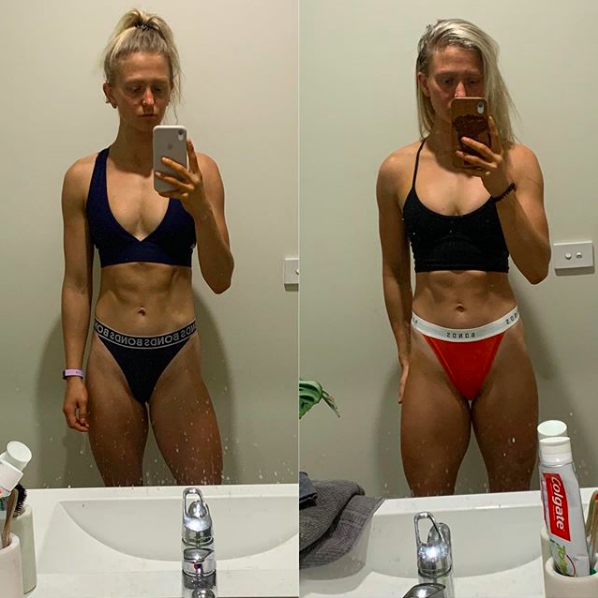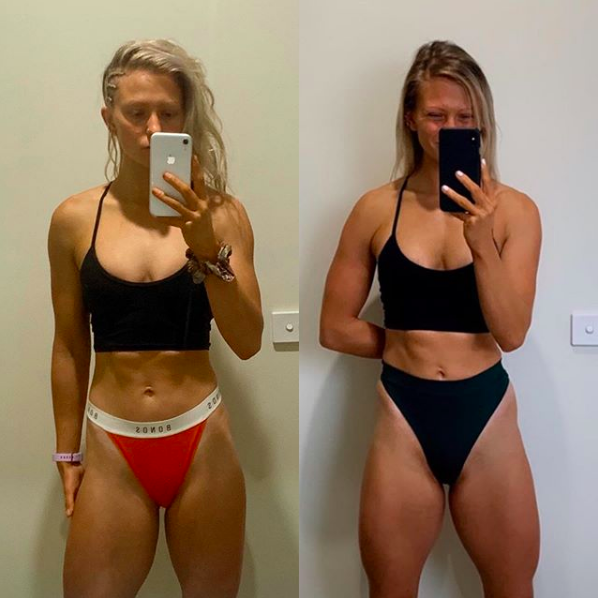Diet Tips
We can yell “calorie deficit” at the people til the cows come home, but along with the psychological component [which is way deeper than is given credit], weight manipulation is a skill. There are however, plenty of tips and tricks we can employ to make dieting or bulking easier for ourselves.
Dieting is challenging. Enduring hunger in the face of delicious food is hard. So any tricks we can employ to make us feel less hungry are extremely favourable.
Similarly, intentionally gaining weight is not without challenges. Bulking is often glorified like “yasss, eat all the food” but ignoring fullness cues and continuing to eat when you feel stuffed is an incredibly uncomfortable, yet oftentimes necessary experience for those looking to add some size.
So what can we do to make losing or gaining weight easier, or at the very least, less uncomfortable?
Disclaimer: none of these are magic tricks. Fasting for a portion of the day isn’t magic, and drinking full fat milk won’t automatically make you gain size. Each of these points simply help to either increase or decrease your experiences of hunger / fullness so you can skew your energy balance in a way that is conducive to your goals.
Moving on…
Tips for Cutting Weight.
Emphasise nutrient dense food. It’s pretty well understood that for most people to drop body fat, eating a diet comprising solely of burgers and donuts probably isn’t a good idea. Why? These foods are extremely calorie dense, offer little nutritional value, and typically aren’t overly filling. AKA, we could go another donut right after we finished the first. Therefore, in order to keep you feeling satisfied so you don’t want to eat everything in sight, you’re better off building the bulk of your diet around foods that are nutrient dense, satiating, and don’t yield a huge number of calories per gram. EG, potatoes, vegetables, lean meats, fruit and low fat yoghurt. Additionally, with a lower calorie intake across the day, you need to hit your minimum micronutrition [vitamin and mineral] targets with a smaller amount of food. For good health, it is important you prioritise this.
Use a smaller eating window. Full disclaimer first of all, this won’t work for everyone. However, having your first meal later in the day and having your last meal earlier can help to comfortably reduce your calorie intake across the course of the day. This is the basis of intermittent fasting. You might relate to this if you feel that you are generally more hungry after you have breakfast. That first meal can act to stimulate your appetite for the hours to follow. I say that this won’t work for everyone as for many, fasting [particularly in the morning] can lead to over eating later on in the day when your hunger hits you like the bus. Your best intentions early in the day can shoot you in the foot later on in the day. This may be worth trialling for you, but be cognisant of the flow on effects.
Eat mindfully. Eat slowly, put your screens away and actually enjoy your meal. For your main meals, eating slowly and more mindfully will enable you to stop eating when you are satisfied, rather than continuing to mindlessly eat beyond the point of comfort. For “treats” like chocolate, ice cream, or a toasty warm hot chocolate, eating mindfully will really allow you to enjoy the food, as opposed to forgetting you even had it and seeking out another one without even realising. If you’re going to enjoy a meal, allow yourself to actually enjoy it by being present while you’re eating.
Learn low calorie substitutions. Dropping weight doesn’t mean you can’t eat the foods that you enjoy, or that you can’t eat with your family any more, or that you can’t eat out. Learning how to make the foods you love lower in calories is incredibly helpful in improving dietary adherence. Some of my favourite substitutions are:
Desserts for diet jelly [virtually no calories]
Soft drinks for diet soft drinks or mineral water [virtually no calories]
Juice for kombucha [about 7 calories per serve instead of 100+]
Hot chocolate for sugar free hot chocolate [virtually no calories]
Pizza bases for cauliflower or pita pizza bases [lower calorie]
Yoghurt for Yo Pro or Chobani yoghurt [lower calorie, much higher in protein]
Pasta for edamame pasta [lower calorie, much higher in protein]
Cereal for oats [more filling]
Dried fruit for fresh fruit [lower calorie per gram, more filling]
Large latte for small latte [consuming less for the same amount of happiness. Just add an extra shot of coffee if you really want the extra caffeine]
Creamy pasta for tomato based pasta [much lower calorie]
I could go all day. Read the nutrition panels of varieties of your favourite foods. The calorie content of similar products can vary significantly from brand to brand. EG, almond milks and pesto sauces can vary by hundreds of calories for what is essentially the same product in terms of taste and utility in cooking.
Limit liquid calories. The glass of OJ with your breaky, the can of Coke with your dinner, and your creamy coffee on the weekend do little to fill you up. They do however add hundreds of calories to your day that could possibly be better used on foods that are both nutritious and satiating. During periods of caloric restriction, it may be best not to drink your calories. If you enjoy flavoured drinks, a mineral water, diet soft drink, diet cordial or kombucha may be better options.
Drink more water. We often mistake hunger for thirst, drinking more water can help to reduce how much we eat later, and can offset more intense feeling of dehydration that drive us towards sweeter beverage options. Drink more water, more regularly.
Limit the condiments. Calories from condiments can really add up, and while delicious, they don’t help us to feel full. More often than not, the ratio of carbs and fats present in many condiments, or provided by the addition of condiments to our meals drives us to eat way more than we would in the absence of said condiment. You don’t need to cut them out completely, but reducing their use can really help to reduce your overall calorie intake across the day. If you want to add flavour to your meals, think more herbs and spices, or lower calorie condiments such as soy sauce, mustard, salsa, sriracha, peri peri or lemon juice.
Plan your meals ahead of time. Some of the most common challenges in the pursuit of weight loss could be easily overcome with a little forward thinking and organisation ahead of time. If you get home from work at 6pm and have nothing around to cook dinner, the odds of ordering Uber Eats are gonna be a lot higher. If you haven’t packed your lunch for work, that cafe downstairs is gonna be real tempting. If you know you get sweet cravings of an evening but you haven’t factored in those calories ahead of time, you’re probably going to exceed your calorie target that day. Give your day some thought either the night before or each morning, plan what you’re having at each meal and any treats or meals out you’d like to have. You can maximise enjoyment and minimise hunger if your day and your meals have some pre-planned structure.
Eat smaller serves. You don’t necessarily need to eat fewer meals, you can just eat smaller ones. Using a smaller plate or a smaller spoon can really help. Hint: if you usually place a huge serving plate in the middle of the table for your family to share, eating smaller serves is likely to be harder for you. Serve up what you plan on eating, and don’t go back to the kitchen. The same can be said about snacks and desserts too. EG, buy smaller pieces of fruit, mini magnums instead of regular sized and fun size chocolates instead of a larger bar.
Individual serves are your best friend. If portion control is something you’re still trying to get your head around, buying pre-packaged smaller servings may be a good way to set the wheels in motion and get you accustomed to enjoying your favourite foods in smaller quantities. EG, single serve tubs of Chobani yoghurt instead of 500g tubs, rice cups instead of a pot of rice, fun size chocolates instead of a block, mini magnums instead of a tub of ice cream. You are less likely to open a whole new packet than you are to serve up “just a little more.”
Practice having a little of the foods you can’t get enough of. Telling yourself “no chocolate, I’m on a diet” is rarely productive long term. As soon as you say you can’t have something, you’re likely to want it 10x more. When you finally cave and get your hands on that forbidden fruit [which is almost inevitable btw bc you are human and flawed], you’re unlikely to have just a bite. To prevent a positive feedback loop of restriction and binge eating, allow yourself to have a little of the forbidden fruit regularly. By having a little bit of chocolate [or your equivalent] every day, you can help to prevent that irresistible urge to eat the whole block in one sitting come Saturday.
Learn to eat out. In some cases, it will be helpful to eat out less if you’re trying to drop body fat. However, being able to make smart choices where you are away from the home is a useful skill to have. Most restaurants do have lower calorie options, it’s just that we’d prefer not to have them. Breakfast is quite easy. Toast, poached eggs, side of veggies, put the butter on the side please, or some similar combination. Acai bowls and porridges are often touted as the healthier option. While they often yield a host of micronutrients via the inclusion of a range of different fruits, nuts and seeds, both are typically extremely calorie dense via the inclusion of juice, cream, milk, nuts / nut butters, or any combination thereof. For lunch of dinner, most restaurants of most cuisines will have a dish that resembles a protein source, vegetables / salad + rice or potato. Steer clear of sugary or creamy sauces such as in sweet and sour dishes and pastas, or meals where the star of the show is not a protein source / vegetable. EG, the chicken and mushroom is not the star of a pizza. If your meal comes out with 100kg of noodles, enough rice for a family, or it’s drowning in sauce, practice leaving some on the plate. Eat mindfully, stop when you’re full, and ask to take the rest home for lunch tomorrow.
Tips for Gaining.
Basically, do the opposite of everything I just said.
Consume more calorie dense food. Note, it is still important to eat your veggies and nurture your physical health. However, if you are only eating low calorie, nutrient dense, highly satiating food, you’re gonna feel very full very quickly. And in the pursuit of building mass, you’re going to be eating past the point of fullness a lot. For good health, it is important to reach minimum daily intakes of each nutrient, however, there are no bonus points for only eating traditionally “healthy foods.” Eat your veggies, eat your protein, eat some fruit and then, add pasta to the side, have some creamy sauce, add cheese, tomato sauce and mayonnaise, butter your toast, have some ice cream, eat some chocolate and if you want a big glass of milo with full cream milk, go for it.
Note, a “dirty bulk” will not make you gain more fat than a clean bulk will. It’s the size of the calorie surplus / how many calories you are consuming on a regular basis that matters. It is important that you know this.
Extend your eating window. Getting more calories in that you’re used to is going to be hard if you don’t have your first meal until lunch time. If you have a relatively large amount of food to get in across the day, have breakfast earlier than you’re used to, and have a final meal / snack right before bed. You will be able to get more food in, more comfortably if you spread your intake out more across the day.
Eat faster. Not so much that you’re struggling to breathe, but if you can eat a little faster, you’ll be able to get slightly more food in before your satiety / fullness signals kick in. If you eat slowly, you will be less likely to finish your meal.
Eat bigger serves. Bigger serves = more food. If you usually have one cup of rice at lunch, have two. If you usually have 150g of chicken, have 200. Half cup of oats? Have a full cup. You don’t always have to eat more meals, just make the ones you are having bigger.
Add condiments. Condiments can add a notable number of calories to our meals without much contribution to our feelings of fullness. Think salad dressings, oils, BBQ / tomato sauce, mayo, aoli, whatever it is you love!
Drink some of your calories. Creamy, milky or sugary beverages can also pack a bunch of calories without leaving you over stuffed. Adding some OJ to each meal and having full fat milk in your coffee and protein shakes each day can add up. Smoothies are also a great idea in the pursuit of mass because you can add a bunch of different nutrient rich foods. EG:
- a base liquid: milk, coconut water, juice [probably not water in the hunt for calories]
- a protein source: probably protein powder
- fruit: berries, banana, pineapple
- a nut butter is damn delicious: peanut or cashew are my personal favs
- plus anything else you want to add in, like cinnamon, creatine, yoghurt, etc.
My personal fav is chocolate coconut water + protein powder + peanut butter + banana + creatine for a generous 550 calories.
Planning is still necessary. Just because you’re trying to gain weight, doesn’t mean you don’t need to plan. So many people get this wrong, thinking gaining weight is just a hall pass to eat whatever, whenever. But getting to 8pm and knowing you still have 1,000 calories left to force feed is a god awful feeling. Be proactive, plan your days, spread your intake across multiple meals and get some calories in early.
Whether you’re gaining or cutting.
Remember, it’s your choice to do so, quite a privilege actually. If the effort required to change your body composition is that demanding, that bad, that uncomfortable and has a net negative impact on your life, no one is forcing you to do it. You don’t have to push on.
But, if the body composition change is important to you and will in the long run, have a net positive effect on your life, it is important to be able to delay gratification. If a little discomfort or a little missing out now has the potential to make your life better later, learn to grit your teeth a little. Play the long game.
Got questions?
Get in touch, I am always happy to chat.
Billie x
PS, I wrote a little about the psychological side of gaining weight and building muscle over on the gram:





